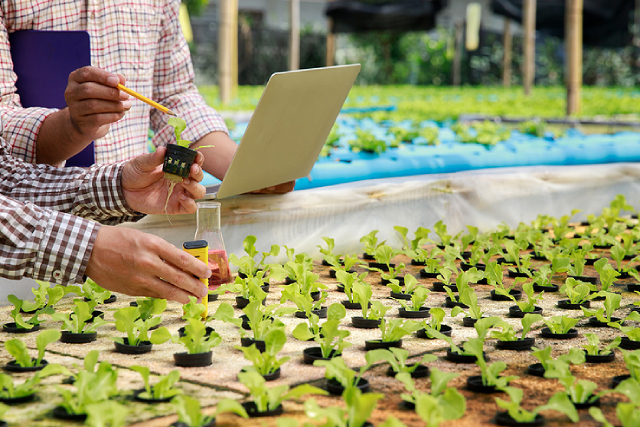
27 Jan A Breakdown of the Key Components of Hydroponic Farming
Hydroponic systems in Singapore are among the latest innovations in food production, marking the next big step in man’s search for new ways to grow food since transitioning to a more stationary, agrarian lifestyle centuries ago. This advancement stems from the discovery that soil is not indispensable to plant growth, only the nutrients it contains. Thus, hydroponic farming is where produce is grown and cultivated via a nutrient solution rather than a soil-like medium.
In this system, plants can redirect their energy to leaf, fruit, and flower production instead of continuously growing their root system in search of water and nutrients. As a result, hydroponic plants have more optimal levels of flavour and appearance with a 2-10 times greater yield at half the time and space than conventional soil-based produce. Below is a breakdown of the main components necessary to get any hydroponic system up and running.
1. Water and Water Basin
As implied in the name hydroponics, water, along with a water basin, is the first key necessity for this type of farming. Filling up the water basin for the first time may use more water than soil gardening, but this is offset by the significantly reduced amount needed in the long run. It is recommended to evaluate the pH level of the water and go for purified or filtered neutral pH as it is easier to change when necessary.
The water basin is the reservoir for the plants to drink from, which can be anything from everyday household storage bins to empty water buckets. While any of these can work, a basin that allows for easy water usage tracking is preferable for quick water top-offs. Moreover, the size of the basin largely depends on the size and number of plants being grown.
2. Light
Although possible outdoors, hydroponic farming is generally located indoors and requires sufficient light sources for the given gardening system. For instance, window light is generally enough for small hydroponic gardens, but larger ones need more light sources. Different plants require different amounts of light, so it is vital to know the kind of plants being grown before installing a lighting system.
3. Temperature Control
A warm atmosphere is key to growing healthy plants, hence the need for temperature control in the grow room. As with light, different plants flourish at various temperatures, but most usually prefer middle to high 21℃. These temperatures need to remain constant between night and day. Besides the atmosphere, the water basin temperature must be monitored and ideally be at room temperature in most cases.
4. Fertiliser or Nutrients
The lack of a soil medium means plants need to get the micronutrients (boron, copper, zinc, etc.) and macronutrients (nitrogen, phosphorus, potassium) they need in another way. These nutrients can be bought separately and mixed on your own or come in premixed solutions specifically for hydroponics and its vegetative and bloom stages of plant growth.
5. Growing Medium
Soil alternatives are a mainstay when creating a hydroponic garden. An example is Rockwool, a porous growing medium used for years in hydroponic plants, providing them with a sterile environment to take root and absorb nutrients and water. Another common and popular medium is coco coir, made from coconut husks. Other mediums used by money-savvy hydroponic gardeners include clean rock or aquarium gravel.
6. Channels, Grow Trays, Tables, and Other Hydroponic-Specific Equipment
Hydroponic plants need a raised surface to sit on top of just above their water source. Depending on the type of hydroponic system, these could be individual trays for each plant, a large one for an entire table, or channels housing several plants at once. These specialised hydroponic containers enable the growing medium to drain properly and redirect overflow back to the water basin for maximum efficiency.
Other types of equipment needed will depend on the given hydroponic system. For instance, wick systems will need air pumps and wicks that dip into the water solution, while drip systems require water pumps, drippers, plastic tubing, and a timer for proper water scheduling.
VPONIC™ Hydroponic Channels and Gutters
VPONIC™ Hydroponic channels, gutters, trays, and other hydro-agriculture solutions are among the top hydroponic products on the market, favoured by many farmers for their effectiveness, versatility, and simplicity. Our hydroponic components are available in various sizes, perfect for any type of hydroponic garden system and growth technique, with the main features including:
- Manufactured using SS141 uPVC pipe potable water/drinking water
- Designed for safe use and devoid of heavy metals and UV rays
- A contoured foundation optimises nutrient flow, allowing excess water to run off
- The simple construction allows for optimal root aeration
- Gutter lids remain secure in all conditions while being easily removed for quick, effective cleaning
Conclusion
After clearing out enough space for a hydroponic garden, growers must procure the proper equipment for their chosen type of hydroponic system. Getting the right equipment for hydroponic farming is paramount as they play a key role in plants’ quick and efficient growth.
When it comes to anything hydroponic farming, Vicplas is the one-stop shop you can trust for all the components you need for your garden. Offering uPVC drainpipes, trays, gutters, and custom-made channels, we are the brand that can get your hydroponic systems up and running with the VPONIC™ fittings, plumbing, and hydroponic plastic components it needs. To learn more about our solutions, don’t hesitate to get in touch with us today.
